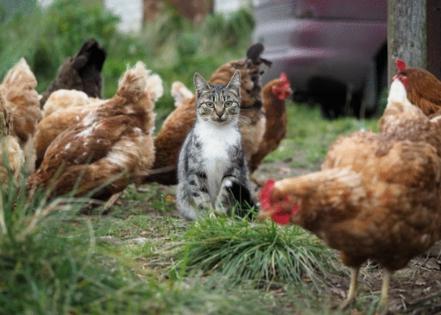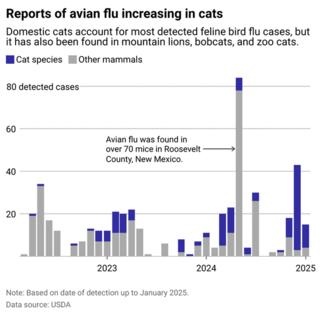Bird flu is on the rise across the US. Are cats at risk?
Published in Slideshow World
Subscribe
Bird flu is on the rise across the US. Are cats at risk?
If you've been shopping for eggs lately, you're probably aware that prices are rising as the latest bird flu outbreak takes its toll on the nation's chickens. The most prevalent strain of the disease, H5N1, has been identified in all 50 states and Puerto Rico, and more than 157 million birds have been affected by the disease since the outbreak began in January 2022.
While avian influenza, aka bird flu, is ravaging wild and farmed bird populations, its transmission to nonavian species—including domestic and wild felines—is also raising alarm bells. The Centers for Disease Control and Prevention reported bird flu found in American dairy cows for the first time in March 2024; by April, CDC officials had confirmed a person exposed to infected dairy cows tested positive for the virus in what is thought to be the first case of transmission from a mammal to a human in this outbreak. According to the CDC, as of Feb. 11, 2025, some 68 people living in the United States have developed bird flu and one person died from the infection since the CDC began reporting on human cases of the virus in March 2024.
The current bird flu epidemic should concern us all. Climate change-related temperature changes, food shortages, and rising seas are changing bird migration patterns, forcing bird populations into new regions and encouraging the spread of the disease. But should cat parents and big-cat caregivers be especially worried about the rise in bird flu cases and transmission?
The risk of felines developing bird flu infections remains relatively low. As of Jan. 31, 2025, 150 wild and domestic cats have been detected with the disease since 2022, according to an analysis of USDA data. Among domestic cats that contracted bird flu, most were feral or dairy farm cats living in close contact with other animals.
It was the identification of bird flu in barn cats that first alerted veterinarians that dairy cows had also contracted the disease. The cats had likely picked up the infection by drinking milk from infected cows.
While the total number of H5N1-infected domestic kitties is still small, researchers and animal advocates say cat owners and caregivers need to start taking action to help keep their pets (and potentially themselves) healthy.
To help better understand the situation at hand, Meowtel used data from the Department of Agriculture to explore the risk of bird flu in cats. Data represents detections and shouldn't be interpreted as an estimate of the total number of cases.
Visit thestacker.com for similar lists and stories.
An uptick in feline bird flu
Researchers continue to learn more about the risks of bird flu in domestic and wild cats and how to mitigate infections. However, it seems most felines develop bird flu after consuming or interacting with wild birds or rodents or consuming raw food, particularly raw meat products, and unpasteurized milk and eggs.
So far, contaminated raw food products have caused illness in at least 13 domestic cats, prompting the voluntary recall of at least one product. In one household in Los Angeles, five indoor-only cats developed bird flu after consuming contaminated commercial raw cat food, of which four developed severe symptoms and two died. Five house cats also died after drinking contaminated milk meant for human consumption.
The Food and Drug Administration has said it is now actively investigating how H5N1 entered the pet food supply chain and requires pet food manufacturers to reassess pet food safety.
How can you tell if your cat has bird flu? Experts say to look for warning signs like fever, respiratory symptoms, lethargy, a loss of appetite, jaundice, red or inflamed eyes, and neurological signs including tremors or seizures.
While bird flu in domestic cats is still extremely rare, seek emergency care if you suspect your cat may have been exposed to bird flu or is experiencing symptoms. It's also wise to isolate potentially infected cats from other animals and immunocompromised humans.
Bird flu primarily spreads through bodily fluids like feces, urine, and saliva, which poses a risk to humans, who tend to cuddle or sleep with their fur babies. While experts don't think cat owners should be very concerned about transmission, they should still exercise caution.
While cats are typically considered "dead-end hosts" in terms of bird flu, meaning they are unable or unlikely to pass the disease to other animals, there have been a small number of recorded cases of bird flu transmission between cats. However, the culprit was a less infectious strain of the virus, H7N2. A veterinarian who came into close contact with the cats also contracted the virus. There are no confirmed cases of H5N1 moving from cats to humans during the current outbreak.
When it comes to protecting your beloved fur baby from bird flu, the experts are clear: Do not feed your cat raw food, whether it be commercially available food or raw meats, poultry, dairy products, or eggs. Stay updated on which pet foods or products have been recalled.
To reduce your kitty's risk of developing bird flu infections the American Veterinary Medical Association recommends keeping pets indoors and preventing their exposure to birds, other wild animals, livestock, and feral animals. The AVMA further suggests practicing strict hygiene measures if you work with or are around wild or farmed animals of any kind.
Some infections wreak devastating effects
At least two facilities housing big cats have been impacted by bird flu, resulting in the deaths of 20 big cats at the Wild Felid Advocacy Center of Washington, a nonprofit animal sanctuary in Shelton, Washington.
While less is known about how captive big cats are being exposed to bird flu, wild bird exposure is the likely culprit, especially given the impacted animals at the Washington Center did not have direct contact with one another. According to the CDC, the death or illness of at least one exotic cat living in a household and an unknown number of known large feline deaths were potentially linked to contaminated raw food.
Zoos, rehabilitation facilities, wildlife parks, sanctuaries, and rescue centers are taking measures to help protect their wild and big cats from bird flu. These include reducing big cat exposure to wild birds and their feces, draining bodies of water that attract waterfowl, limiting access to birds to designated workers, closing off aviary enclosures to the public, and pausing feedings and other events where the public interacts with birds.
A few facilities are also disposing of stored food, deep cleaning big cat enclosures, quarantining animals, and screening visitors who come into contact with birds in their facilities.
By following some basic precautions, you can mitigate your cat's risk of developing bird flu and help reduce its spread and impact on humans.
Story editing by Natasja Sheriff Wells. Additional editing by Alizah Salario. Copy editing by Paris Close. Photo selection by Ania Antecka.
This story originally appeared on Meowtel and was produced and distributed in partnership with Stacker Studio.









Comments